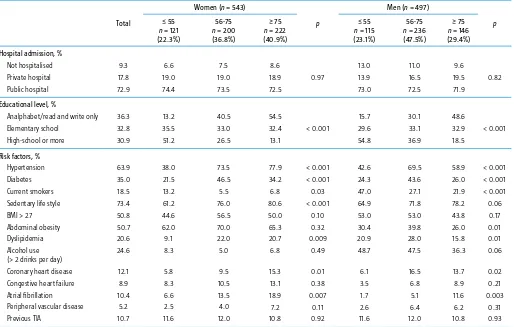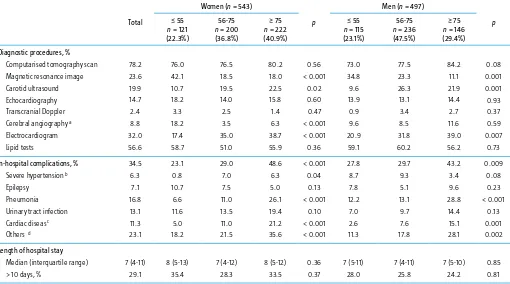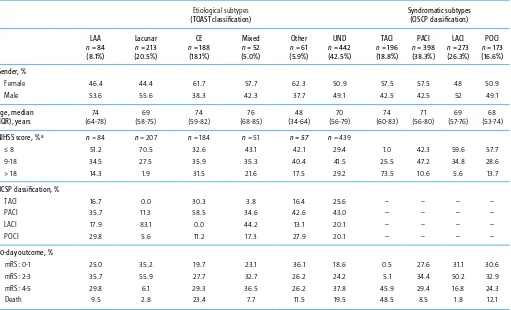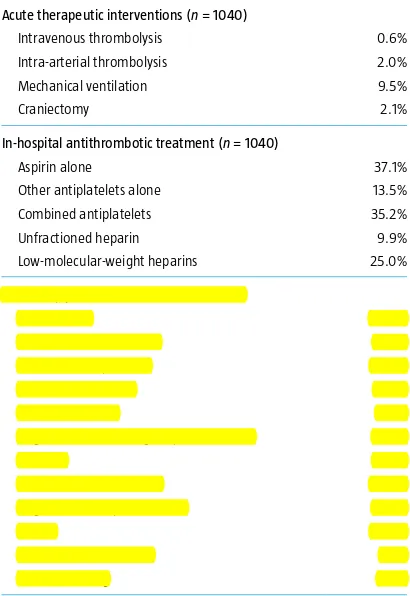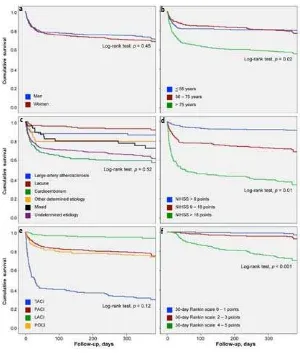Introduction
Stroke is a growing health problem in countries liv-ing the epidemiological transition, so that by the year 2005, 85% of deaths attributed to stroke around the world occurred in low- to middle-income coun-tries [1]. In Mexico the scarce published informa-tion on cerebrovascular diseases is mainly derived from a few third-level centres focusing in some par-ticular topics [2-4]. In order to increase the knowl-edge on acute stroke care in this emerging econo-my, the Asociación Mexicana de Enfermedad Vas-cular Cerebral (AMEVASC) created the PREMIER registry (Primer Registro Mexicano de Isquemia Ce-rebral). he main goal of this efort is to describe the current clinical practice in diagnosis, treatment, and prevention of acute ischaemic stroke (AIS) and transient ischaemic attack (TIA), as well as to anal-yse the one-year outcome. he present report focus on patients with irst-ever AIS, with the aim to de-scribe: 1) relative frequency of vascular risk factors;
2) clinical and aetiological subtypes of AIS; 3) use of diagnostic procedures and acute treatment strat-egies; 4) use of secondary prevention at hospital discharge; and 5) clinical outcome in the irst 12 months after AIS. his study represents the irst multicentre report on hospital-based acute care of AIS performed in Mexico. his is the irst of the PREMIER series.
Patients and methods
he PREMIER study is a prospective, hospital-based multicentre registry on consecutive patients with AIS or TIA in Mexico. All members of AME-VASC working in second- and third-care level hos-pitals from diferent geographic regions of Mexico were invited to participate. he registry included 77 physicians (91% neurologists and 9% trained inter-nists on cerebrovascular disease) from 59 urban centres of diferent types: 39 public and 20 private
Acute care and one-year outcome of Mexican patients
with first-ever acute ischaemic stroke: the PREMIER study
Carlos Cantú-Brito, José L. Ruiz-Sandoval, Luis M. Murillo-Bonilla, Erwin Chiquete, Carolina León-Jiménez, Antonio Arauz, Jorge Villarreal-Careaga, Ricardo Rangel-Guerra, Alma Ramos-Moreno,
Fernando Barinagarrementería; and the PREMIER Investigators.
Department of Neurology; Instituto Nacional de Ciencias Medicas y Nutrición Salvador Zubirán; Mexico City (C. Cantú-Brito). Department of Neurology (J.L. Ruiz-Sandoval); Department of Internal Medicine (E. Chiquete); Hospital Civil de Guadalajara Fray Antonio Alcalde; Guadalajara. Department of Neurology; Faculty of Medicine; Universidad Autónoma de Guadalajara; Zapopan (L.M. Murillo-Bonilla). Department of Neurology; Hospital Valentín Gómez Farías; Zapopan (C. León-Jiménez). Stroke Clinic; Instituto Nacional de Neurología y Neurocirugía; Mexico City (A. Arauz). Department of Neurology; Hospital General de Culiacán; Culiacan (J. Villarreal-Careaga). Department of Neurology; Hospital Universitario de Monterrey; Monterrey (R. Rangel-Guerra). Strategic Clinical Research; Sanofi-Aventis; Mexico City (A. Ramos-Moreno). Department of Neurology; Hospital Angeles de Querétaro; Querétaro, México (F. Barinagarrementería).
Corresponding author:
Carlos Cantú-Brito MD, PhD. Department of Neurology. Instituto Nacional de Ciencias Médicas y Nutrición Salvador Zubirán. Vasco de Quiroga, 15. Col. Sección XVI. CP 14439. Tlalpan, Mexico City, Mexico.
E-mail:
carloscantu_brito@hotmail.com
Conflicts of interest:
This registry received unrestricted funds from Sanofi-Aventis.
The PREMIER Investigators: Steering Committee.
C. Cantú-Brito, J.L. Ruiz-Sandoval, L. Murillo-Bonilla, J.A. Arauz- Góngora, J. Villarreal-Careaga, F. Barinagarrementería, R. Rangel-Guerra, E. Chiquete. Introduction. Information on acute care and outcome of Mexican patients with ischaemic stroke is lacking. The aim of this
report is to provide results of a first step stroke surveillance system and outcome at one year of follow-up.
Patients and methods. In the PREMIER study 1,376 patients from 59 Mexican hospitals were included from January 2005 to June 2006. Of these, 1,040 (52% women, mean age 67.5 years) with first-ever cerebral infarction are here analyzed. Five visits were completed during the one year follow-up.
Results. Main risk factors were hypertension (64%), obesity (51%) and diabetes (35%). Total anterior circulation stroke syndrome occurred in 19% of patients, partial anterior in 38%, lacunar in 26% and posterior stroke syndrome in 17% cases. In 8% the stroke mechanism was large-artery atherosclerosis, in 18% cardioembolism, in 20% lacunar, in 6% miscellaneous mechanisms and in 42% the mechanism was undetermined, mainly due to a low use of diagnostic resources. Although 17% of patients arrived in < 3 h from stroke onset, only 0.5% had IV thrombolysis. Only 1% received endarterectomy or stenting. The 30-day case fatality rate was 15%. At one-year of follow-up, 47% had a modified Rankin score 0-2 (independent), 23% had 2-5 (dependent) and 29% died. One-year acute ischaemic stroke recurrence rate was 8%.
Conclusion. In Mexico a significant proportion of patients arrive on time for thrombolysis, but very few receive this therapy. There is a low use of diagnostic resources to assign aetiology. Thirty-day case fatality rate doubles at 1-year after acute ischaemic stroke.
hospitals. Public hospitals included 32 second-level and 7 third-level hospitals, which serve areas of 0.5 to 10 million inhabitants and are the main health care providers for stroke patients in their regions. he PREMIER neurologists represented 15% of the total certiied Mexican neurologists, and participat-ing centres corresponded to 10% of the public and 15% of the private hospitals in Mexico; respectively. Investigators were asked to provide the number of AIS patients they see per year and who could follow for at least one year with complete and accurate in-formation. hus, a quota of 15 patients minimum was set, and with a maximum of 25 patients per in-vestigator, in order to assure completeness and ac-curate description of the follow-up events. As a re-sult, 11 centres originally invited were excluded as a participating site. hen, new centres were invited and additional training workshops were held.
Recruitment period and data collection
Consecutive patients were included in the registry if they were ≥ 18 years of age, with clinical ischae-mic stroke syndromes conirmed by neuroimaging (head CT or MRI), and who received medical care (either hospitalised or as outpatients) within 7 days of stroke onset. Patients were excluded if complete information could not be obtained. As practiced in other registries [5], a pilot recruitment started in 7 third-level academic centres to verify the feasibility of the computerised database and then it was ex-tended to the public and private community hospi-tals; after reviewing, amendments and improve-ments were applied. Using a standardised struc-tured questionnaire outlined in a procedure manu-al, prospective data were collected. In this manumanu-al, deinitions of study variables were clearly described to ensure consistent information. A three-day work-shop was organised before enrolment, addressing a review of stroke guidelines, exercises on strokes subtypes –TOAST and Oxfordshire Community Stroke Project (OCSP) classiications– [6] and vid-eo training on use of the National Institutes of Health Stroke Scale (NIHSS) and modiied Rankin scale (mRS) scorings. Information registered was about demographics, time elapsed from stroke on-set to hospital arrival, vascular risk factors, NIHSS score at admission to emergency room, in-hospital diagnostic and treatment procedures, medical com-plications, and use of secondary stroke preventive measures. he patients were evaluated at hospital discharge and at 30 days; as well as 3, 6, 12 and 18 months after AIS. Outcome variables included the mRS, Folstein’s mini-mental state examination,
lab-oratory tests, neuroimaging studies, new hospitali-sations, and vascular recurrences. Deaths were re-corded as related to stroke, other vascular, unrelated to stroke, and of unknown cause. Syndromatic and aetiological stroke classiications were validated by members of the Steering Committee (CCB, JLRS, LMB, ECh).
Hypertension, diabetes, past or current smoking habit, sedentary life style and alcohol abuse were deined following international standards, as previ-ously reported [3,4]. Medical complications occur-ring duoccur-ring follow-up were registered based on cri-teria prevailing in each centre, at investigator’s dis-cretion. All data were recorded in an electronic ile at the sites and were sent to a data management centre (Contract Research Organisation, CRO: In-noval Co.), where information was rechecked for completeness and plausibility. Missing or implausi-ble data were referred to the treating clinician for clariication. Data quality was assured by periodic reports and clinical site visits by CRO monitors (10% of the participating centres were randomly audited). A central Institutional Review Board and the local Committee of Ethics of each participating centre approved the protocol.
Statistical analysis
Parametric continuous variables are expressed as geometric means and standard deviations (SD), or minimum and maximum. Non-parametric contin-uous variables are expressed as medians and inter-quartile range. Categorical variables are expressed as percentages. To compare quantitative variables distributed between two groups, Student t test (ANOVA test when > 2 variables) and Mann-Whit-ney U test (Kruskal-Wallis test when > 2 variables) were performed in distributions of parametric and non-parametric variables, respectively. Chi-square statistics (i.e., Pearson’s chi-square or Fisher’s exact test, as corresponded) were used to compare nomi-nal variables in bivariate anomi-nalyses. Kaplan-Meyer survival estimates and Cox proportional hazard re-gression model at 12 months were constructed to ind determining independent variables of AIS out-come. All p values are two-sided and regarded as signiicant when p < 0.05. SPSS v. 13.0 software was used for all statistical calculations.
Results
From January 2005 to June 2006, 1431 consecutive patients with acute cerebral ischaemia were
recruit-Investigators and centers.
ed (either TIA or AIS). Fifty-ive patients were ex-cluded due to missing information. Of the remain-ing 1376 patients, a total of 130 (9.4%) TIAs and 206 (15%) recurrent strokes were excluded. hus, 1040 cases of irst-ever AIS were analysed for the present report: 543 (52.2%) women and 497 (47.8%) men, with a mean ± SD age of 67.5 ± 15.9 years. A total of 943 (90.7%) were hospitalised either in pub-lic (n = 758, 72.3%) or private institutions (n = 85, 17.8%). Only 97 (9.3%) patients received medical care as outpatients. Table I shows relevant charac-teristics of the cohort at inclusion in the registry, by gender and age. he proportion of women was much higher than that of men in the oldest group (40.9% vs 29.4%; p < 0.001). he most important vascular risk factors were hypertension, obesity and diabetes. In the older ages hypertension was more common among women than in men. Obesity was highly prevalent in the total cohort (> 50%),
partic-ularly in women. More current smoking habit (30.2% vs 7.7%; p < 0.001) and alcohol abuse (44.5% vs 6.4%; p < 0.001) occurred in men than in women, especially in the youngest group. Conversely, con-gestive heart failure (11.0% vs 6.6%; p = 0.01) and atrial ibrillation (14.2% vs 6.2%; p < 0.001) were signiicantly more common in women.
Of the 943 patients who were hospitalised, 163 (17.3%) arrived within 3 h of stroke onset and 165 (17.5%) in 3-6 h. At hospital admittance, NIHSS was determined in 926 patients: 343 (37%) had NIHSS of < 8 points, 360 (38.9%) had 9-18 points and 223 (24.1%) had NIHSS of > 18 points. Table II describes the diagnostic procedures used during the acute care of patients. Remarkably, there was a very low use of diagnostic resources to establish AIS mechanisms. A lipid proile was obtained in 57% of patients in the irst visit, while a carotid ul-trasound was practiced in only 20% and
echocar-Table I. Demographic data and vascular risk factors in patients with first-ever ischaemic stroke (n = 1.040).
Total
Hospital admission, % Not hospitalised Private hospital Public hospital
Educational level, %
Analphabet/read and write only Elementary school
High-school or more
Risk factors, % Hypertension Diabetes Current smokers Sedentary life style BMI > 27 Abdominal obesity Dyslipidemia Alcohol use (> 2 drinks per day) Coronary heart disease Congestive heart failure Atrial fibrillation Peripheral vascular disease Previous TIA
BMI: Body Mass Index; TIA: transient ischaemic attack.
diography in 15% of patients. he median hospital stay was 7 days, being higher in women than in men (> 10 days in 32% vs 25.9%; p = 0.03), but without diferences across age groups. Medical complica-tions during hospitalisation were frequent (34.5%), and patients who had in-hospital complications more commonly had a hospital stay > 10 days (56.2% vs 29.8%; p < 0.001).
Table III shows demographics, stroke severity, and short-term outcome by stroke subtypes, ac-cording to OCSP and TOAST classiications. Total anterior circulation stroke syndrome occurred in 18%, partial anterior in 38%, lacunar in 26% and posterior stroke syndrome in 17% of cases. AIS mechanisms according to TOAST criteria were as follows: 8% large-artery atherosclerosis, 18% cardi-oembolism, 20% lacunes, 6% miscellaneous mecha-nisms and 42% undetermined. Cardioembolism was particularly common in elderly women (62%), associated with a high NIHSS (in 32% > 18 points) and with a worse 30-day outcome (mRS 4-5: 29%, mRS 6: 23%). Stroke of undetermined cause was also
associated with a poor 30-day outcome (mRS ≥ 4: 58%). As expected, lacunar strokes were associated with a better short-term prognosis (mRS ≤ 3: 91%). Notably, among cardioembolic AIS cases, 30% cor-responded to a total anterior, and 58% to partial an-terior circulation syndromes.
Table IV describes the acute therapeutic inter-ventions in the whole cohort and secondary pre-ventive measures that were prescribed to survivors. Of the 1040 patients, 27 (2.6%) received either in-travenous (n = 5; 0.5%) or intra-arterial (n = 22; 2.1%) thrombolysis. Moreover, IV thrombolysis was practiced in only 6.8% of the 231 patients having a hospital arrival in < 3 h. Other of-label, non-ap-proved acute medications (i.e., steroids and other drugs) were prescribed in 9% of patients. Carotid endarterectomy or stenting was performed in < 1% of patients.
he median follow-up was 358 days (mean 245.3 days, range 0 to 691 days). A total of 219 (21%) pa-tients were lost by the last follow-up visit. he in-hospital case fatality rate was 13.5%. Long-term
clin-Table II. Diagnostic procedures and in-hospital complications in patients with first-ever ischaemic stroke (n = 1.040).
Total
Diagnostic procedures, % Computarised tomography scan Magnetic resonance image
In-hospital complications, % Severe hypertension b
Length of hospital stay Median (interquartile range) > 10 days, %
a Angio-MRI, angio-CT, or digital subtraction angiography; b Systolic blood pressure ≥ 190 mmHg on admission; c Arrhythmias, heart failure, acute coronary syndromes; d Include acute
gastroin-testinal bleeding, sepsis, acute renal failure, metabolic disturbances.
Matamoros, Tamaulipas: A. Aguirre- Álvarez (Hospital Privado). Saltillo, Coahuila: A. Cárdenas-Ateneo (IMSS).
Accepted:
15.09.10.
How to cite this article:
Cantú-Brito C, Ruiz-Sandoval JL, Murillo-Bonilla LM, Chiquete E, León-Jiménez C, Arauz A, et al. Acute care and one-year outcome of Mexican patients with first-ever acute ischemic stroke: the PREMIER study. Rev Neurol 2010; 51: 641-9.
© 2010 Revista de Neurología
ical outcome is pictured in igure 1. A funnel efect is evident at one year of follow-up, so that around one third of patients had mRS: 0-1 (excellent recov-ery), another third had mRS: 2-5 (moderate to se-vere disability) and the other third died. Figure 2 shows Kaplan-Meyer survival estimates at 1-year follow-up, according to relevant demographics, stroke syndromes, aetiological subtypes and 30-day Rankin scale. Survival was lower among the older patients, in those with high NIHSS at hospital ad-mittance and in patients with a worse mRS at 30 days. One-year case fatality rate was not modiied by gender or AIS subtypes.
Discussion
In the last four decades the incidence of stroke has decreased in developed countries, while it has dou-bled in low- to middle-income nations [1,7]. In
Mex-ico, it is estimated that more than 27 000 deaths oc-cur each year as a consequence of stroke [8].Here we report that largely modiiable risk factors are re-sponsible for AIS in Mexico, with important difer-ences between age groups and genders. Some vas-cular risk factors present in Mexican patients with AIS are similar to other stroke registries in Latin America [9,10]. Mexicans present a higher frequen-cy of diabetes, but a lower relative frequenfrequen-cy of smoking, coronary heart disease and atrial ibrilla-tion, than in some European stroke registries [9,11,12]. Considering that the Mexican population has changed its age pyramid towards an expanded longevity, it is estimated that an increase in the in-cidence of cardiovascular and cerebrovascular dis-eases will take place during the next decades [13,14].
Worryingly, even when a ifth of patients arrived on time for IV thrombolysis, less than 1% of the pa-tients who arrived early received this treatment, compared to other studies, in which rtPA treatment
Table III. Demographics, stroke severity and short-term outcome by stroke subtypes, in first-ever ischaemic stroke. Etiological subtypes
Age, median (IQR), years
OCSP classification, % TACI
30-day outcome, % mRS: 0-1
among all AIS admissions range from 1.6% to 17.2% [15-18]. As described in other developing countries [19], this is partially due to high costs of rtPA, lim-ited access to specialised medical care to obtain ac-curate and timely diagnosis, limited specialised personnel (i.e. either general or stroke neurologists) in some hospitals or lack of organised stroke teams in emergency rooms.
Most AIS were classiied as undetermined due to a limited availability of diagnostic resources. Compared to other world registries, this represents a very low use of complete diagnostic procedures to assign ischemic stroke aetiology [11,12,20,21]. As a consequence, only 8% of events were classiied as due to large-artery atherosclerosis, whereas up to 42% were undetermined events. Similar indings were observed in another predominantly Hispanic Mestizo population, in a community-based setting in Chile, where the proportion of undetermined events was 38% [22]. he low frequency of large-ar-tery atherothrombotic irst-ever AIS among Mexi-can patients could be explained by under-ascertain-ment of AIS mechanisms, as for example, only 20% of patients had practiced a carotid Doppler ultra-sound, and < 10% had an intracranial vascular as-sessment. Indeed, when we analysed the subgroup of patients classiied as undetermined, we found that around 40% of them had two or more large-ar-tery risk factors and also had evidence of athero-sclerosis in other vascular territories (i.e., coronary, aortic and lower-limb peripheral arteries). here-fore, we could speculate that most of these patients actually correspond to large-artery disease
aetiolo-gy. On the other hand, this registry shows a pre-ponderance of stroke due to cardioembolism in women, whereas men showed more cases of large-artery atherosclerosis and lacunar strokes. Similar to other studies, we found that cardioembolic mecha-nism was commonly associated with TACS syn-drome (i.e., large infarcts) and with a high case fatal-ity rate and functional disabilities [23,24].A prece-dent study with a similar methodology was the ReNa Cer registry conducted in Argentina [25]. Simi-lar igures are seen between our study and the Ar-gentinian registry with respect to some risk factors, access to thrombolysis and medical complications.
Acute case fatality is high and it doubles at one year after AIS. he number of medical complica-tions (especially infeccomplica-tions) recorded in this regis-try is distressing, as a high rate of in-hospital deaths could be attributed mainly to this potentially pre-ventable factor. Improving general nursing care and reducing the number of complications would prob-ably decrease this scenario [25]. Case-fatality rate is increasing with time and higher than that observed
Figure 1. Functional outcome at 30 days, 90 days, 6 months, and 12 months of follow-up as assessed by the modified Rankin scale in patients with first-ever ischaemic stroke.
Table IV. Early therapeutic interventions in patients with first-ever ischae-mic stroke.
Acute therapeutic interventions (n = 1040) Intravenous thrombolysis
Intra-arterial thrombolysis Mechanical ventilation Craniectomy
0.6% 2.0% 9.5% 2.1%
In-hospital antithrombotic treatment (n = 1040) Aspirin alone
Other antiplatelets alone Combined antiplatelets Unfractioned heparin Low-molecular-weight heparins
37.1% 13.5% 35.2% 9.9% 25.0%
Secondary prevention measures (n = 888) Aspirin alone
Other antiplatelets alone Combined antiplatelets Oral anticoagulation Antihypertensives
Angiotensin-converting enzyme inhibitors Diuretics
Calcium-channel blockers Angiotensin receptor blockers Statins
Carotid endarterectomy Carotid stenting
in other stroke registries. For comparison, in the SORCan study stroke case fatality was 7%, 13%, and 24%, at 7 days, 30 days, and 1 year; respectively [23]. Secondary prevention strategies showed dei-ciencies according to current evidence-based guide-lines [26,27].he rate of patients on secondary pre-vention with antithrombotic drugs at discharge was high. Around 97% of patients were prescribed anti-platelet agents or oral anticoagulants. However, the proportion of patients receiving antihypertensives and statins seems rather low, in virtue of the fre-quency of dyslipidemia and current evidences on their beneit in atherothrombosis prevention [28-30]. he applied methodology in this registry could not determine whether observed deiciencies in secondary prevention could be attributed to either patient factors or poor clinician compliance to guidelines, or both. Similar to other registries [26], our 1-year recurrence rate was 8%.
Stroke surveillance requires systematic collection to generate the knowledge to establish and assess health policies and interventions.Disparities are ob-served on resource allocation in developing coun-tries, mainly when economical support to medical care is based on the importance of diseases as causes of death [19]. herefore, there is an urgent need for an active participation of scientiic societies in lead-ing joint eforts with government and industry for properly planning and action. Population should be informed on risk factors, clinical manifestations, preventive measures of cerebrovascular diseases and the importance of medication compliance [31].
Our study has several limitations that should be addressed. his is not a population-based study, as-certainment of AIS mechanisms was limited and follow-up is relatively short, considering current standards. Nonetheless, considering that consecu-tive patients from public and private hospitals from almost all geographical regions of Mexico have been included, and the fact that this registry is pri-marily a surveillance of current practice [32], we believe that this registry pictures real-life hospital care of AIS in a nation.
In conclusion, PREMIER is the irst nation-wide hospital-based registry in collecting data on acute care and outcome of AIS in Mexicans. here is an opportunity to improve quality of stroke care by implementing speciic measures and ad hoc treat-ment guidelines [26,27,30]. Economical and socio-cultural factors afecting infrastructure and techni-cal support could impose barriers to delivering the best acute and long-term care. Deiciencies and limitations to accurately classify and treat a stroke
in a timely manner could have signiicantly inlu-enced the outcome of Mexican patients with irst-ever AIS.
References
1. Johnston SC, Mendis S, Mathers CD. Global variation in stroke burden and mortality: estimates from monitoring, surveillance, and modelling. Lancet Neurol 2009; 8: 345-54. 2. Barinagarrementería F, Ruiz-Sandoval JL, Arauz A, Amaya L,
Cantú C. A hospital stroke register in Mexico City: analysis of 2045 patients. Neurology 1999; 52 (Suppl 2): S442. 3. Arauz A, Cantú C, Ruiz-Sandoval JL, Villarreal-Careaga J,
Barinagarrementería F, Murillo-Bonilla L, et al. Pronóstico a corto plazo de la isquemia cerebral transitoria. Registro multicéntrico de enfermedad vascular cerebral en México. Rev Inv Clin 2006; 58: 530-9.
Figure 2. Kaplan-Meier estimates of the 12-month mortality for patients with first-ever ischaemic stroke (n = 1040), as a function of gender (a), age group (b), ischaemic stroke mechanisms (c), NIHSS at admis-sion (d), Oxford Community Stroke Project classification (e) and 30-day Rankin score (f).
a
f e
d c
4. Ruiz-Sandoval JL, Cantú C, Chiquete E, León-Jiménez C, Arauz A, Murillo-Bonilla LM, et al. Aneurysmal subarachnoid hemorrhage in a Mexican multicenter registry of cerebro-vascular disease: the RENAMEVASC registry. J Stroke Cerebrovasc Dis 2009; 18: 48-55.
5. Ruiz-Sandoval JL, Ortega-Álvarez L, García-Navarro V, Romero-Vargas S, González-Cornejo S. Hemorragia intra-cerebral en un hospital de referencia de la región centro-occidente de México. Rev Neurol 2005; 40: 656-60. 6. Amarenco P, Bogousslavsky J, Caplan LR, Donnan GA,
Hennerici MG. Classiication of stroke subtypes. Cerebrovasc Dis 2009; 27: 493-501.
7. Feigin VL, Lawes CM, Bennett DA, Barker-Collo SL, Parag V. Worldwide stroke incidence and early case fatality reported in 56 population-based studies: a systematic review. Lancet Neurol 2009; 8: 355-69.
8. Estadísticas sobre mortalidad general. SINAIS, Mexico, 2008. URL: http://sinais.salud.gob.mx. [24.07.2010].
9. Röther J, Alberts MJ, Touzé E, Mas JL, Hill MD, Michel P, et al. Risk factor proile and management of cerebrovascular patients in the REACH registry. Cerebrovasc Dis 2008; 25: 366-74.
10. Lavados PM, Hennis AJM, Fernandes JG, Medina MT, Legetic B, Hoppe A, et al. Stroke epidemiology, prevention, and management strategies at a regional level: Latin America and the Caribbean. Lancet Neurol 2007; 6: 362-72. 11. Grau AJ, Weimar CH, Buggle F, Heinrich A, Goertler M,
Neumaier S, et al. Risk factors, outcome, and treatment in subtypes of ischemic stroke. he German Stroke Data Bank. Stroke 2001; 32: 2559-66.
12. Moreno VP, García-Raso A, García-Bueno MJ, Sánchez-Sánchez C, Meseguer E, Mata R, et al. Factores de riesgo vascular en pacientes con ictus isquémico. Distribución según edad, sexo y subtipo de ictus. Rev Neurol 2008; 46: 593-8. 13. Ruiz-Sandoval JL, León-Jiménez C, Chiquete-Anaya E, Sosa-
Hernández JL, Espinosa-Casillas CA, Cantú C, et al. Estilos de vida y prevención primaria y secundaria de enfermedad vascular cerebral. Rev Invest Clin 2010; 62: 181-91. 14. Villalpando S, Rodrigo JR. he status of non-transmissible
chronic disease in Mexico based on the National Health and Nutrition Survey 2006. Introduction. Salud Publica Mex 2010; 52 (Supl 1): S2-3.
15. Deng YZ, Reeves MJ, Jacobs BS, Birbeck GL, Kothari RU, Hickenbottom SL, et al. IV tissue plasminogen activator use in acute stroke. Experience from a statewide registry. Neurology 2006; 66: 306-12.
16. Nadeau JO, Shi S, Fang J, Kapral MK, Richards JA, Silver FL, et al. tPA use for stroke in the registry of the Canadian Stroke Network. Can J Neurol Sci 2005; 32: 433-9. 17. Weimar C, Kraywinkel K, Maschke M, Diener HC; German
Stroke Study Collaboration. Intravenous thrombolysis in German stroke units before and after regulatory approval of recombinant tissue plasminogen activator. Cerebrovasc Dis 2006; 22: 429-31.
18. García-García J, Gracia-Gil J, Sopelana-Garay D, Ayo-Martín O, Vadillo-Bermejo A, Touza B, et al. Administración de tratamiento trombolítico intravenoso en el ictus isquémico en fase aguda: resultados en el Complejo Hospitalario Universitario de Albacete. Rev Neurol 2008; 46: 7-12.
19. Durai Pandian J, Padma V, Vijaya P, Sylaja PN, Murthy JM. Stroke and thrombolysis in developing countries. Int J Stroke 2007; 2: 17-26.
20. Kapral MK, Laupacis A, Phillips SJ, Silver FL, Hill MD, Fang J, et al. Stroke care delivery in institutions participating in the registry of the Canadian Stroke Network. Stroke 2004; 35: 1756-62.
21. Liu X, Xu G, Wu W, Zhang R, Yin Q, Zhu W. Subtypes and one-year survival of irst-ever stroke in Chinese patients: the Nanjing Stroke Registry. Cerebrovasc Dis 2006; 22: 130-6. 22. Lavados PM, Sacks C, Prina L, Escobar A, Tossi C, Araya F, et al. Incidence, case-fatality rate, and prognosis of ischemic stroke subtypes in a predominantly Hispanic-Mestizo population in Iquique, Chile (PISCIS project): a community-based incidence study. Lancet Neurol 2007; 6: 140-8. 23. Saposnik G, Hill MD, O’Donnell M, Fang J, Hachinski V,
Kapral MK, et al. Variables associated with 7-day, 30-day, and 1-year fatality after ischemic stroke. Stroke 2008; 39: 2318-24.
24. Reggiani M; Società Inter-Regionale Piemonte e Valle d’Aosta per le cerebrovasculopatie Group. Five-year survival after irst-ever ischemic stroke is worse in total anterior circulation infarcts: the SINPAC cohort. Cerebrovasc Dis 2009; 27: 29-36.
25. Sposato LA, Esnaola MM, Zamora R, Zurrú MC, Fustinoni O, Saposnik G, et al. Quality of ischemic stroke care in emerging countries: the Argentinean National Stroke Registry (ReNACer). Stroke 2008; 39: 3036-41.
26. Arauz A, Murillo-Bonilla L, Leyva A, Barinagarrementería F, Alegría MA, Villarreal-Careaga J, et al. Guía de práctica clínica para la prevención secundaria de la enfermedad vascular cerebral después de la fase aguda. Rev Invest Clin 2010; 62: 130-4.
27. Barinagarrementería F, Arauz A, Ruiz-Sandoval JL, Cantú C, Leyva A, Murillo L, et al. Antiplaquetarios en la prevención del infarto cerebral o isquemia cerebral transitoria atero-trombótica. Rev Invest Clin 2010; 62: 135-40. 28. Arrospide-Elgarresta A, Mar J, Vivancos-Mora J,
Rejas-Gutiérrez J, Caro J. Estudio coste-efectividad del uso de dosis altas de atorvastatina en la prevención secundaria del ictus en España. Rev Neurol 2010; 51: 1-11.
29. Fernández de Bobadilla J, Moreno R, Fernández C, Martínez A, Sánchez-Maestre C, Ezpeleta-Echevarri D. Efecto del tratamiento intensivo con atorvastatina frente a dosis estándar de estatinas en el riesgo de ictus de pacientes con enfermedad coronaria previa. Metaanálisis de cinco ensayos aleatorizados con 25.709 pacientes. Rev Neurol 2009; 48: 561-5. 30. Cantú C, Villarreal J, Barinagarrementería F, Ruiz-Sandoval JL,
Arauz A, Leyva A, et al. Estatinas en la prevención secundaria de enfermedad vascular cerebral. Rev Invest Clin 2010; 62: 162-9.
31. Pérez-Lázaro C, Íñiguez-Martínez C, Santos-Lasaosa S, Alberti-González O, Martínez-Martínez L, Tejero-Juste C, et al. Estudio sobre el conocimiento de la población acerca del ictus y de los factores de riesgo vascular. Rev Neurol 2009; 49: 113-8.
Manejo agudo y pronóstico a un año en pacientes mexicanos con un primer infarto cerebral: resultados del estudio multicéntrico PREMIER
Introducción. Se carece de información sobre el cuidado agudo y pronóstico de mexicanos con infarto cerebral. El objetivo de este informe es proveer los resultados de un sistema multicéntrico de vigilancia hospitalaria en ictus isquémico agudo.
Pacientes y métodos. En el estudio PREMIER se incluyeron 1.376 pacientes de 59 hospitales entre enero de 2005 y junio de 2006. De éstos, se analizaron 1.040 (52% mujeres; edad promedio: 67,5 años) con un primer infarto cerebral. Cinco visitas se completaron durante un año de seguimiento.
Resultados. Los principales factores de riesgo fueron hipertensión (64%), obesidad (51%) y diabetes (35%). Un 19% de los pacientes se presentó con un síndrome de circulación anterior total, un 38% de circulación anterior parcial, un 26% la-cunar y un 17% de circulación posterior. En el 8%, el mecanismo del ictus fue aterotrombosis de grandes arterias, el 18% fue cardioembólico, el 20% lacunar, el 6% misceláneo y el 42% indeterminado. Aunque un 17% de los pacientes llegó en menos de tres horas de ocurrido el ictus, sólo al 0,5% se le realizó trombólisis intravenosa. Se practicó endarterectomía o colocación de endoprótesis arterial en el 1%. La mortalidad a 30 días fue del 15%. Al año de seguimiento, un 47% tuvo una puntuación en la escala de Rankin modificada de 0-2 puntos (independiente), un 23% tuvo 2-5 (dependiente) y un 29% falleció. La tasa anual de recurrencia fue del 8%.
Conclusión. En México, una proporción significativa de pacientes llega en tiempo para trombólisis, pero muy pocos la reciben. Existe un bajo uso de recursos de diagnóstico para asignar la etiología del infarto cerebral. La tasa de fatalidad a 30 días se duplica un año después del ictus.
